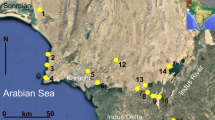Abstract.
The study of Upper Quaternary sedimentary sequences in the Pechora Sea by means of vibrocoring revealed three sediment units. The (youngest) sandy unit accumulated in marine environments later than 5000 years B.P. The clayey unit belongs to a pro-deltaic facies, probably formed during Middle Holocene times. The diamict unit formed during Middle/Early Weichselian times, probably has a glacigenic origin and is separated from the clayey unit by a hiatus. The changes in lithology are partly related to changes in Pechora River discharge during late Weichselian/Holocene times.
Similar content being viewed by others
Author information
Authors and Affiliations
Additional information
Electronic Publication
Rights and permissions
About this article
Cite this article
Levitan, M., Kuptsov, V., Romankevich, E. et al. Some indication for late Quaternary Pechora River discharge: results of vibrocore studies in the southeastern Pechora Sea. Int J Earth Sci 89, 533–540 (2000). https://doi.org/10.1007/s005310000133
Received:
Accepted:
Issue Date:
DOI: https://doi.org/10.1007/s005310000133




